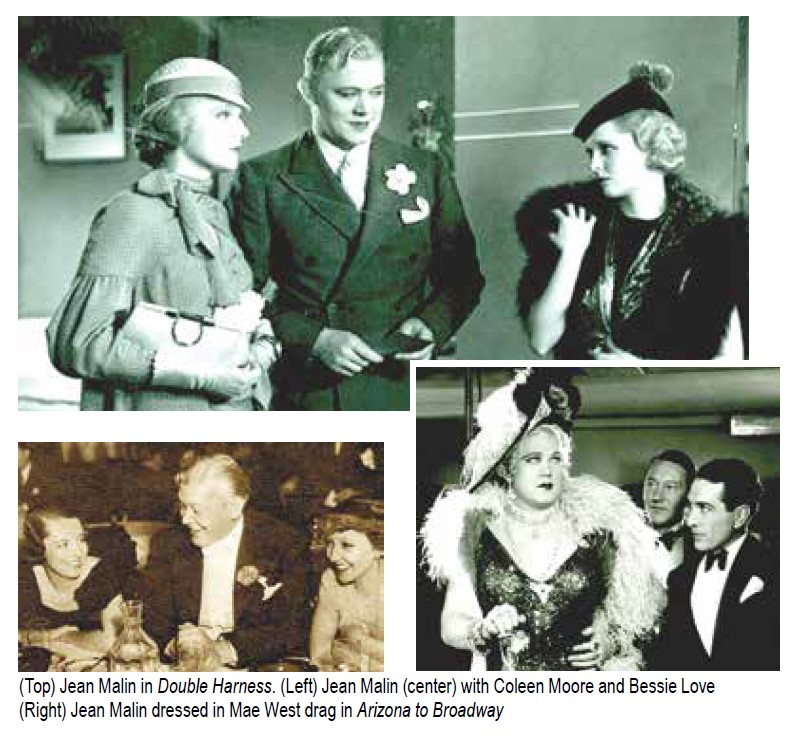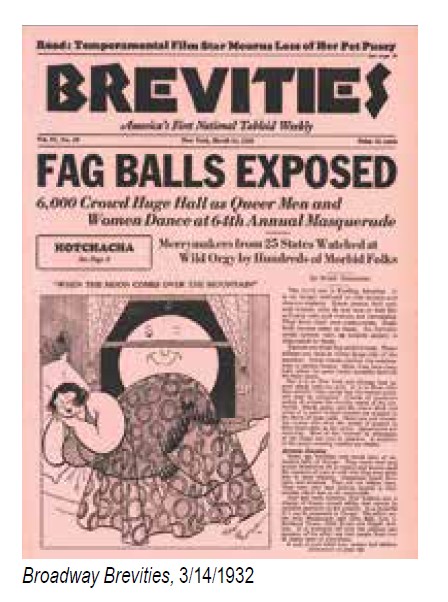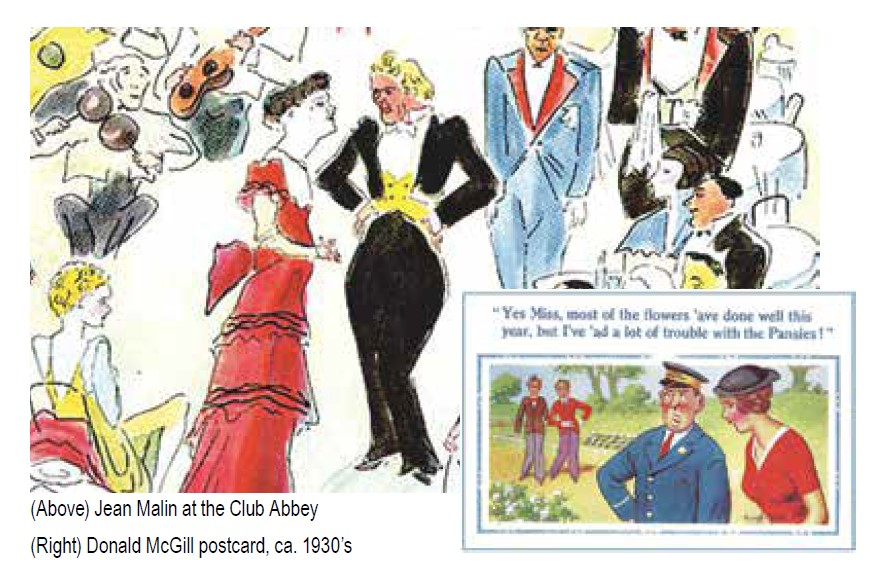
By Dr. Bill Lipsky–
Some years after it happened, the nationally syndicated columnist Dorothy Kilgallen told her readers about a fight in a Greenwich Village club in 1928 or 1929. “Jean walked into Hot Feet late one morning and a tipsy group of men made some loud comments on his blondined hair. Jean picked up a champagne bottle by the neck, broke the bottom off on a table and went to work. The fracas lasted for an hour and two dozen men went to a hospital.”
Jean was Jean Malin, soon to be a master of ceremonies in tony Broadway and Hollywood nightclubs and the most famous personality of the short-lived “pansy craze” of the late 1920s and early 1930s. In another version of the story, he was in drag when he entered the club, which caused the comments that started the brawl. He won in that account, too, concerned only with “the disgraceful state my gown is in” when it was over.
However the details differed from one story to another, the import was always the same. Here was something new, something different: a gay man standing up for himself in public, defending himself and the right to be himself against all comers—and winning the confrontation. Being six feet tall and weighing 200 pounds, Malin was no one’s idea of a stereotypical swishy, nelly queen, although he could swish with the best of them.

Born Victor Eugene James Malinovsky on June 30, 1908, in Brooklyn, New York, Malin knew who he was at an early age. He was working as a drag performer at the Rubaiyat in Greenwich Village as Imogene “Bubbles” Wilson—also the name of a famous Ziegfeld Follies showgirl—when Louis Schwartz, one of the owners of an uptown, upscale club (the notorious gangster “Dutch” Schultz allegedly was another) saw him perform and offered him a job.
Schwartz wanted Malin to emcee a show that would “give Broadway its first glimpse into pansy night life.” Wearing elegant evening clothes, Malin opened at the Club Abbey in the Spring of 1930, just as the “pansy craze” was sweeping New York. “Making no bones about earning his living as a ‘professional pansy,’” he “strolled through the club, delighting, astonishing, and occasionally infuriating a mostly heterosexual audience with his camp wit.”

The audience often became part of the show. When guests talked back to the performers, heckling them, taunting them, Malin responded with searing wise cracks—his speciality—that always put them in their place. As the columnist Arthur Pollock noted, “Perhaps those men in the audience who jeered at him were merely plants … but if his tart retorts were spontaneous, he is a smart fellow.” This queen kept his dignity always. He simply would not be dissed.
Many commentators disapproved of homosexuality’s new overtness with barely coded language. Vanity Fair referred to the “lavender mist” that surrounded the show and the syndicated gossip columnist Gilbert Swan wrote of the “tremendous vogue among the night lifers for young men who walk with four fingers at their hips.” He could not understand the popularity of a master of ceremonies “who just a few years ago was just another shrinking violet.” Malin laughed all the way to the bank.
According to the tabloid Broadway Brevities, New York’s “pansies hailed La Malin as their queen” and he became a darling of the city’s café society. He was out of a job in less than a year, however. After a gangland shooting at the club in January 1931, the police shut it down—it was, of course, selling liquor illegally during Prohibition—and began to move against the other “pansy clubs.” In a few years, all were gone.

Malin moved on to Hollywood, opening at the Club New Yorker, a block from the Chinese Theater, in 1932. Variety thought “his wise cracks and flip remarks, especially to noisy guests,” would “hit strong with the smart mob, particularly the picture crowd,” but would leave the “home boys and girls wondering what it was all about.” The publication described Malin as “a class entertainer” who “shows most of the local café performers how it should be done.”
They did not need the instruction. During 1932, La Boheme starred the renowned Karyl Norman, “The Creole Fashion Plate,” famous for his gowns, mostly sewn by his mother. Clarke’s showcased Francis Renault, née Antonio Auriemma, praised for his Lillian Russell impression, and Jimmie’s Backyard featured Rae Bourbon in his revue “Boys Will be Girls.” If not a golden age, it certainly was a magical year.
Malin closed at the Club New Yorker in May 1933, then moved across the street to perform in the Chinese Theater’s live prologue to Warner Brothers’ Gold Diggers of 1933. His own experience with the movie studios was very brief. His one on-screen appearance, in an uncredited part, was as a Mae West imitator in Arizona to Broadway (1933); typical of Malin, when one of the mob running the theater disrespects him, his character, in full drag, floors him with a single right hook.
Other studio experiences were less satisfying. He filmed “a violetty part” as dress-shop owner Bruno in Double Harness (1933), but his scenes were reshot with a so-called “less effeminate” actor before the movie was released. Studio president B.B. Kahane later told his staff, “I do not think we ought to have this man on the lot on any picture—shorts or features.” The scenes he filmed for Dancing Lady (1933), starring Clark Gable and Joan Crawford, were only seen on the cutting room floor.
An automobile accident ended Marlin’s career and his life on the night of August 10th, 1933. After a “farewell appearance” at the Ship Café on Venice Pier, he and his “close friend” Jimmy Forlenza and screen comedienne Patsy Kelly left for a party at the Hollywood Barn Café on Sunset Boulevard. Malin accidentally put car the car into reverse and it careered backwards off the pier into the ocean. His two guests survived the disaster, but Malin did not. He was barely 25 years old.
Bill Lipsky, Ph.D., author of “Gay and Lesbian San Francisco” (2006), is a member of the Rainbow Honor Walk board of directors.
Published on September 10, 2020
Recent Comments